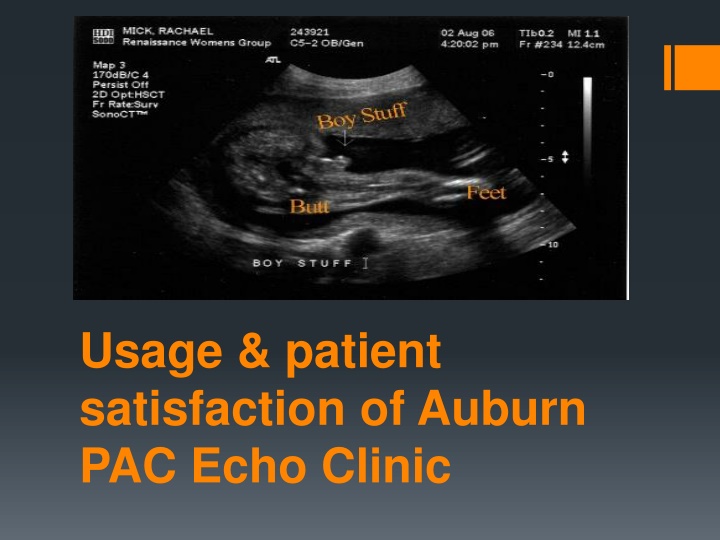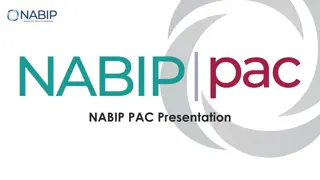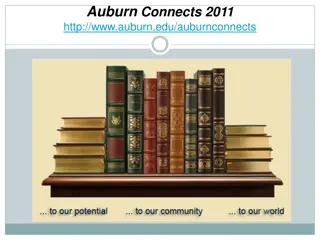Analysis of Auburn PAC Echo Clinic: Usage and Patient Satisfaction
Auburn PAC Echo Clinic is a specialized facility run by anesthesiologists providing diagnostic services for ambulatory patients attending the Pre-Admissions Clinic. The clinic's unique approach includes specific referral guidelines for Transthoracic Echocardiogram (TTE) assessments, contributing to improved patient management and reducing risks. A detailed audit evaluated patient satisfaction and clinical usage, highlighting the clinic's effectiveness. Literature reviews showcase the clinic's distinctive outpatient-only model operated by anesthesiologists, with similar examples being rare globally.
Download Presentation

Please find below an Image/Link to download the presentation.
The content on the website is provided AS IS for your information and personal use only. It may not be sold, licensed, or shared on other websites without obtaining consent from the author.If you encounter any issues during the download, it is possible that the publisher has removed the file from their server.
You are allowed to download the files provided on this website for personal or commercial use, subject to the condition that they are used lawfully. All files are the property of their respective owners.
The content on the website is provided AS IS for your information and personal use only. It may not be sold, licensed, or shared on other websites without obtaining consent from the author.
E N D
Presentation Transcript
Usage & patient satisfaction of Auburn PAC Echo Clinic
Auburn Pre Admissions clinic HIGH VOLUME LOW ANAESTHETIC RISK CENTRE PAC 5 days a week (VMO + Registrar) Approximately 4,900 patients annually The Echo Clinic Run by 2 FANZCAs with post graduate qualifications in diagnostic TTE (PGrad CU DDU) Started in 2013 Exclusive service for ambulatory patients attending PAC prior to elective surgery Reduce risk in our patients with easy access to TTE
How it works Patients are identified in PAC through clinical assessment Auburn has its own referral guidelines for TTE Referral criteria : ECG changes Excluding Cardiac aetiology Murmur or click Significant LV systolic dysfunction Right heart failure pulmonary hypertension Known or suspected adult congenital heart disease or has corrected congenital heart disease Prosthetic valve TTE > 3 years ago FHx of sudden cardiac death/early cardiac events (first degree relatives) Significant HTN with LVH on ECG Age 80+, moderate risk surgery to assess LV dysfunction Patient requires HDU for medical reasons
The Audit The Audit had 2 components To assess patient satisfaction in those who attend the Auburn PAC Echo clinic Patient satisfaction was assessed through a simple 4-part questionnaire To assess the clinical usage of the service by measuring its effect on patient management Clinical usage was assessed by considering the indications for TTE the prevalence and type of pathology found its affect on the patient management
Available knowledge Literature review demonstrated that the Auburn PAC Echo clinic is unique! Its OUTPATIENT ONLY, run by ANAESTHETISTS, Its DIAGNOSTIC (TTE performed and reported by DDUs) Its exclusively for Auburn PAC patients Conventional access to TTE is via hospital cardiology departments or private cardiology clinics There are a few examples of Anaesthetist run clinics: Canty et al (2012) at Royal Hobart Hospital Farris et al (2012) at Joondalup Hospital in Perth Shillcutt et al (2015) in Nebraska, USA
Methods clinical audit assessed patients attending the Echo Clinic between September 2019 and August 2020 (1 year) a 4-part questionnaire was completed via telephone. Undertaken by non-clinical staff via phone after Echo performed Referrals, TTE results and EMR was reviewed for: the indications for TTE (with a 13th criteria for when guidelines weren't met) the prevalence and type of pathology found its affect on the patient management Outcomes were divided into 5 categories: 1 No changes proceed 2 Proceed + cardio review in future 3 Proceed + anaesthetic consideration suggested 4 Delay + further investigation 5 Cancelled
Results (Patient satisfaction) 29 patients (37%) were successfully contacted after attending the Auburn PAC Echo clinic Only 1 (3%) were not happy with the care they received 3 patients (10%) did not feel they had enough information about their clinic appointment and testing
Results (Patient satisfaction) Question 3 identified that 6 patients (20%) could have used more information beforehand Only one patient made a suggestion to improve the service, saying everything Other comments made by patients were generally very positive, including the convenience of having the test undertaken in the public system, professional conduct of staff , and the doctors were very good and funny .
Results (Clinical usage) Over the 1-year period a total of 78 patients received a TTE. The average age was 64, with 58% male and 42% female (with no one identifying as gender neutral). Age 90+ 0 80-89 8 70-79 24 60-69 21 50-59 17 40-49 4 30-39 1 20-29 3 <20 0 0 5 10 15 20 25 30
Results (Clinical usage) Referral criteria:
Results (Clinical usage) 29% of TTEs demonstrated pathology that affected patients management in some way. Examples of commonly identified pathology include moderate LV systolic /diastolic dysfunction and moderate valvular disease. A few very significant findings included moderate to severe pulmonary hypertension LVOT obstruction and structural defects such as VSDs. It should be noted that the Echo clinicians had to reinforce the fact that TTE in itself cannot rule out ischaemic heart disease when writing their reports.
Results (Clinical usage) 72% of patients having an echo proceeded to surgery without change or influence on patient management. Cardiology review was suggested in 15% of patients that could be undertaken AFTER the procedure. In 7% of patients it was suggested that the operation could proceed but anaesthetic considerations were suggested Procedures were postponed in 5% of patients Only 1 case was cancelled (1%)
Discussion Patient satisfaction at the Auburn PAC Echo clinic is overall very good. Only one patient was unhappy with their care A proportion of patients had little understanding of what TTE is or why it is undertaken One suggestion was that an information pamphlet could be supplied to explain the why and how of TTE. It is noted that the survey achieved a low response rate (37%) The reason for a response rate of 37% is multifactorial
Discussion Referral to the Auburn PAC Echo clinic is currently at the discretion of the PAC Clinician (with referral guidelines to aid in decision- making) There is still no definitive consensus for referral guidelines to undertake TTE in the perioperative environment (Canty et al., 2012; Faris et al., 2012 An analysis of referrals and their likelihood of demonstrating clinically significant disease and/or their effect on patient management could be undertaken (so as to validate, expand or focus current local referral criteria)
Discussion The utility of TTE in the diagnosis of myocardial ischemia: Multiple referrals were made in this vein where other diagnostics tests have a much higher sensitivity and specificity Rates of pathology identification (29%) were similar to multiple other similar studies (26% farkis et al, 27% Botker et al) Patient disposition after the TTE is of greatest importance - only 4 cases were postponed and 1 was cancelled in a 12- month period. 72% of patients proceeded without influence on patient management, which is significantly higher than a study conducted at Royal Hobart hospital (Canty et al; (54%).
Limitations A low patient satisfaction survey response potential interviewer bias as the survey was conducted by a member of the anaesthetic department An overall lower than usual number of TTEs were undertaken due to the effects of COVID-19 on elective surgery. This study is not applicable to other similar studies for a number a reasons including the diagnostics qualifications of the anaesthetists, and the limitations on post operative destinations (i.e. no HDU or ICU referral available at Auburn hospital). There is significant conjecture as to what defines a clinically significant lesion as well as what is appropriate referral criteria for echo.
Conclusion and suggestions The patient experience for those undertaking testing at the Auburn PAC Echo clinic is good. There are clear issues around patient understanding of the test itself or the reasons for undertaking it. A simple patient focused information pamphlet A new survey should also be considered A small number of postponed or cancelled cases could potentially save NSW Health significant cost with reduced retrieval and intensive care services.
Conclusion and suggestions There are likely further hidden benefits such as referral to cardiology services for the surveillance and management of pathology There may be room to improve or refine referral criteria and a further study could be conducted into the validity of the current criteria. Referral criteria should also consider reasons not to refer, such as ruling out myocardial ischaemia. The use of the service has declined since its inception.
References: Botker, M. T., Vang, M. L., Grofte, T., Sloth, E., & Frederiksen, C. A. (2014). Routine pre-operative focused ultrasonography by anesthesiologists in patients undergoing urgent surgical procedures. Acta Anaesthesiol Scand, 58(7), 807-814. doi:10.1111/aas.12343 Canty, D. J., Royse, C. F., Kilpatrick, D., Bowman, L., & Royse, A. G. (2012). The impact of focused transthoracic echocardiography in the pre-operative clinic. Anaesthesia, 67(6), 618-625. doi:10.1111/j.1365-2044.2012.07074.x Douglas, P. S., Khandheria, B., Stainback, R. F., Weissman, N. J., Brindis, R. G., Patel, M. R., . . . Society of Critical Care, M. (2007). ACCF/ASE/ACEP/ASNC/SCAI/SCCT/SCMR 2007 appropriateness criteria for transthoracic and transesophageal echocardiography: a report of the American College of Cardiology Foundation Quality Strategic Directions Committee Appropriateness Criteria Working Group, American Society of Echocardiography, American College of Emergency Physicians, American Society of Nuclear Cardiology, Society for Cardiovascular Angiography and Interventions, Society of Cardiovascular Computed Tomography, and the Society for Cardiovascular Magnetic Resonance endorsed by the American College of Chest Physicians and the Society of Critical Care Medicine. J Am Coll Cardiol, 50(2), 187-204. doi:10.1016/j.jacc.2007.05.003 Faris, J. G., Hartley, K., Fuller, C. M., Langston, R. B., Royse, C. F., & Veltman, M. G. (2012). Audit of cardiac pathology detection using a criteria-based perioperative echocardiography service. Anaesth Intensive Care, 40(4), 702-709. doi:10.1177/0310057X1204000418 Fincham, J. E. (2008). Response rates and responsiveness for surveys, standards, and the Journal. Am J Pharm Educ, 72(2), 43. doi:10.5688/aj720243 Fleisher, L. A., Fleischmann, K. E., Auerbach, A. D., Barnason, S. A., Beckman, J. A., Bozkurt, B., . . . Wijeysundera, D. N. (2014). 2014 ACC/AHA guideline on perioperative cardiovascular evaluation and management of patients undergoing noncardiac surgery: a report of the American College of Cardiology/American Heart Association Task Force on Practice Guidelines. Circulation, 130(24), e278-333. doi:10.1161/CIR.0000000000000106 Lenk, T., Whittle, J., Miller, T. E., Williams, D. G. A., & Bronshteyn, Y. S. (2019). Focused cardiac ultrasound in preoperative assessment: the perioperative provider's new stethoscope? Perioper Med (Lond), 8, 16. doi:10.1186/s13741-019-0129-8 Rohde, L. E., Polanczyk, C. A., Goldman, L., Cook, E. F., Lee, R. T., & Lee, T. H. (2001). Usefulness of transthoracic echocardiography as a tool for risk stratification of patients undergoing major noncardiac surgery. Am J Cardiol, 87(5), 505- 509. doi:10.1016/s0002-9149(00)01421-1 Shillcutt, S. K., Brakke, T. R., Thomas, W. R., Porter, T. R., & Lisco, S. J. (2015). The development of a perioperative echocardiography consult service: the Nebraska experience. J Cardiothorac Vasc Anesth, 29(3), 777-784. doi:10.1053/j.jvca.2014.09.010 Smilowitz, N. R., & Berger, J. S. (2020). Perioperative Cardiovascular Risk Assessment and Management for Noncardiac Surgery: A Review. JAMA, 324(3), 279-290. doi:10.1001/jama.2020.7840























